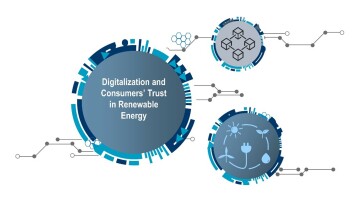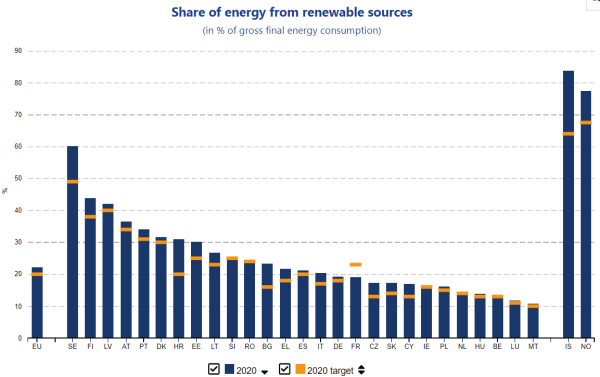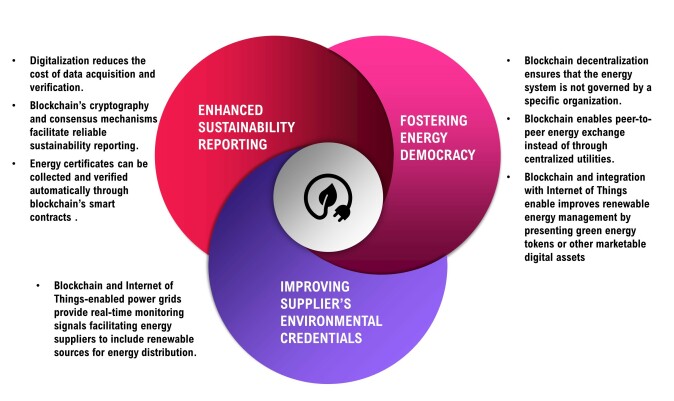
FUI-Bloggen
FUI är förkortningen för forskning, utveckling och innovation. I FUI-bloggen skriver Yrkeshögskolan Novias personal om sitt jobb, forskning, projektverksamhet och andra betraktelser.
Blogginlägg som är granskat av Novias redaktionsråd är utmärkta med nyckelordet "Granskat inlägg".
Vi följer CC-BY 4.0 om inget annat nämns.
Digitalization and Consumers’ Trust in Renewable Energy

Interest in green energy remains on the rise, and an increasing number of businesses are making it a priority in their communications. While governments and industries work to reduce reliance on traditional fossil fuels by investing in renewables, it is crucial to preserve the public trust in the value of renewable energy.
The energy systems and power infrastructure has played and will continue to play a significant role in the economy’s decarbonization. Decarbonizing the energy system entails replacing fossil fuels with low-carbon technologies such as renewables and hydrogen, as well as an emphasis on energy efficiency. Over the last 15 years, we have seen a remarkable shift from fossil fuels toward more green energy systems throughout the world [1, 2]. At the EU level, the share of renewable energy from total energy consumption grew steadily from 9.6 % in 2004 to 22.1 % in 2020 [3]. Estimates suggest that electricity consumption may double by 2050, due to growing demand as electricity replaces fossil fuels to power cars, and households’ electricity or heating [4]

Figure 1. Share of energy from renewable sources in % of gross energy consumption (source: Eurostat [3]).
Achieving net zero emissions will require changes in consumers’ behaviors to decarbonize their lifestyles and they must receive transparent information on the carbon content of tariffs to make informed energy decisions. Sustainability is becoming increasingly essential to customers when selecting a product, expecting firms to utilize sustainably sourced materials, reduce company CO2 emissions and energy consumption, and demonstrate transparency in how a product is manufactured. However, recent research indicates that consumers often find it difficult to trust the information supplied on manufactured products regarding their environmental claims or pledges, particularly the use of green energy [5, 6].
That lack of consumer trust comes primarily from an overflow of irrelevant and sometimes confusing information. Moreover, several research studies have demonstrated consumers’ concerns about greenwashing and self-congratulatory communication. Hence, there is an urgent need that the electricity supplied through the utility grids to provide information regarding how it was generated, its origin and its environmental impacts (e.g., carbon footprint). Lately, there have been attempts to fill this gap through for example Renewable Energy Certificates (REC) in accounting, tracking, and assessing the ownership of energy supply and consumption. Yet, it is still not possible for consumers to easily understand what portion of the energy they are consuming or using for the products/services are from renewable sources and which sources.
Improving visibility and transparency in the source of renewables as well as providing information regarding carbon offsetting, and footprint impact are crucial in shaping consumers’ opinions and willingness to pay for novel green energy resources. Digitalization and rapid developments of Information and Communication Technology (ICT), the Internet of Things (IoT), and the Internet of Energy (IoE) are increasingly gaining traction in searching for solutions needed for sustainable energy generation. Recently, the integration of IoT and distributed ledger technologies including blockchain technology facilitated a transparent and reliable framework for traceability and supply chain management in different sectors. These digital solutions seem to play an important role in the near future in improving trustworthy communication regarding renewable energy production and consumption. Digital solutions have the potential to enhance companies’ sustainability disclosures (e.g., sustainability reporting) to deliver an honest account of their impacts. Moreover, the integration of different digital solutions offers a trustworthy framework for customers, investors, and other stakeholders to assess energy suppliers’ environmental credentials. Furthermore, digitalization can provide more decentralized options for public participation and therefore public support of green energy development. Digitalized frameworks can cater for a broad range of consumer motivations – from those who are willing to pay more for decarbonization, to more price-conscious consumers who are willing to support green energy at the lowest cost possible. The following sections briefly discuss the potential of digital solutions and particularly blockchain technology to improve transparency on the environmental credentials of energy suppliers, foster energy democracy, and gain consumer trust via enhanced sustainability reporting.

Figure 2. Potential areas that digitalization can improve trustworthy communication regarding renewable energy.
Transparency on supplier’s environmental credentials
Customers must be able to assess their supplier’s environmental credentials by determining the amount of energy they have sourced from renewable resources. The European Internal Markets Electricity (IME) Directive 2019/944/EC [7] places an obligation on the Member States to implement ‘electricity source disclosure’ schemes for power sold to end users through a process called Fuel Mix Disclosure. This refers to the information a supplier is required to include on its invoice about the proportion of each energy source to the overall fuel mix provided by the supplier and indicating associated environmental impacts.
The commitment to reveal supplier’s fuel mix was first initiated in 2005 as part of the EU’s ‘Consumer Agenda’ for energy with the aim that the provision of information on the fuel mix disclosure would allow consumers to make informed decisions about the environmental consequences (CO2 emissions, etc.) of the electricity they buy. As a result, the implication was that once informed, customers may choose more efficient and environmentally friendly energy options [8]. Also, power suppliers are obliged to declare the origin of supplied energy (2018/2001/EU, Article 19.8 [9]; 2019/944/EU, Annex 1.5 [7]). Moreover, Member States’ policy instruments for promoting renewable energy and high-efficiency cogeneration (e.g., quota obligations, tax exemptions, etc.) may also require a comparable allocation of these attributes in near future.
The IEM Directive 2019/944/EC of the European Parliament and of the Council (and its predecessors 1996/92/EC [10], 2003/54/EC [11] and 2009/72/EC [12]) create a framework for promoting high-efficiency cogeneration in the internal market and harmonizing green energy market across the EU’s Member States. This requires a real-time monitoring system that can operate efficiently at national and international levels. Nevertheless, the implementation of such ‘tracking’ systems would be challenging (for good economic and operational reasons). Tracking the energy contracts requires a lot of effort, since energy may be traded several times before it is supplied. Besides, equal amounts of energy from various technologies may be swapped, leading to mixed flows of energy. Assessing the production mix of supplied energy becomes even more complicated when the effect of international trade is also included.
The revolutionary development of smart grids enabled by IoT systems has accelerated the rise of renewable energy production. IoT-enabled power grids provide real-time monitoring signals facilitating energy utilities to include renewable sources for energy distribution. This switching mechanism improves smart grids’ performance in supporting the varying nature of renewable energy and ensures an uninterrupted power supply.
In addition, recent developments in distributed ledger mechanisms, notably blockchain technology, enable efficient renewable energy management by presenting green energy tokens or other marketable digital assets [13]. Blockchain is a decentralized immutable ledger of transactions (called blocks that are encrypted and securely connected) which facilitates the secure data management and transparent tracking of assets in a specified network. Blockchains are typically administrated via a peer-to-peer (P2P) network of computer nodes working as a distributed ledger, where nodes jointly adhere to a consensus algorithm protocol to add and authenticate new transaction blocks. Blockchain can support the development of peer-to-peer (P2P) energy trading platforms where information regarding the origin of the particular energy carrier as well as financial distributions are simply trackable and accessible due to its transparent architecture and interoperability mechanism [14, 15]. It is especially essential for small-scale renewable energy producers, which are often disregarded from carbon credit procedures owing to their complexity and expensive claiming costs [13]. Regardless of trade volumes, blockchain’s smart contract mechanism prevents double-spending and facilitates issuing automatic green energy certificates while reducing transaction costs [16, 17].
Energy democracy and empowering consumers
As the transition towards more renewable-based energy systems is gaining momentum, the concept of energy democracy is emerging [18]. The energy democracy emphasizes community engagement to create opportunities for destabilizing power relations by substituting monopolized fossil fuel energy regimes with renewable and decentralized systems [19]. Energy democracy, based on the notion of participatory governance and civic ownership [20], advocates powering communities completely with renewable energies while communities themselves maintain the ownership of the supplied energy in a decentralized structure [21, 22]. Energy democracy offers a new economic growth model by establishing a clear link between local green energy production and local consumption [23]. In this model, energy citizens [24] are individuals acting as prosumers (i.e., both generating and using energy [25, 26]), and will gain substantially higher economic advantages [27, 28].
Blockchain seems to play a big role in the establishment of energy democracy and transforming citizens into prosumers. Blockchain enables peer-to-peer energy exchange instead of through centralized utilities. Blockchain decentralization ensures that the energy system is not governed by a specific organization or even the government. As an example, a recent EU-funded project based at the Vrije Universiteit Brussel set up a prototype of a blockchain-based decentralized energy grid [29]. In this system, excess energy generated from household solar panels will be injected into a local smart grid, generating one unit of energy currency (called NRGcoin) for each kilowatt-hour which can be exchanged with traditional money in the market. In situations where their demand is higher than their solar panel can provide, they can purchase each kilowatt-hour at the same price from another generator in the network [30]. Enabling more local generation and peer-to-peer trading contributes to the development of a more resilient energy network since all of the actors are helping to run and maintain the grid.
Fostering sustainability reporting and consumer trust
A genuine Circular Economy necessitates a multifaceted approach to resource efficiency. One that considers not just raw material supplies but also energy sources. Renewable energy sources are currently becoming more feasible alternatives to fossil fuels. The most popular renewable energy sources are solar and wind energy, however, recently researchers are also investigating other renewable energy sources such as microalgae, biomass, microbes, and hydrogen.
A successful shift towards a circular economy and energy transition demands significant investments in renewable energy ventures and consumer support. As public concerns for climate change raises alongside rigorous environmental standards, social acceptance of green energy solutions has also risen. Recent studies indicated that consumers have heightened expectations of providers of products and services across all industries to demonstrate their sustainability commitment, in particular concerning renewable energy. Therefore, businesses are under growing pressure to provide a thorough sustainability report that depicts their real environmental effect, not just for investors and regulators, but also to inform consumers. Green energy performance and carbon emissions became obligatory measures in the sustainability reports since fuel combustion accounts for more than 70% of the greenhouse gas emissions in the EU-27.
Major challenges that businesses are confronting regarding energy data and reporting are the costs, granularity, and certificate collection. For most businesses, the shift towards the green revolution has led to cost-saving opportunities including the possibility to gain access to low-cost renewable energy. However, it has resulted in increased costs due to additional compliance and regulation, and sustainability reporting. The big challenge is accessing energy data including green energy certificates, and the associated carbon emissions. The presence of different intermediaries adds to the complexities of the retrieval and processing of energy data. Examples of intermediaries include external auditors, multiple energy suppliers, sustainability advisors, and energy management systems. Existing intermediaries reduce the speed of information provision and increase the cost.
Access to details and assessing the accuracy of detailed data is another challenge. Increasingly, corporations are expected to reveal more accurate information and ensure there is adequate context on these metrics to enable a highly granular analysis of real environmental impacts. As a result, leaders in sustainability reporting are already shifting toward real-time carbon accounting granularity. For instance, a new initiative called ‘Energy Tag’ emerged to establish a market for hourly power certificates, allowing energy customers to verify instantaneously the source of their electricity and carbon emissions [27].
Moreover, procurement managers face the problem of data auditing and credibility issues. In terms of auditing, there is a general skepticism concerning corporates’ data and impacts. The auditing procedure is costly and reliant only on samples, undermining the credibility of the company. Furthermore, auditing is a resource-intensive process in which energy managers must devote a consistent amount of time to compile and submit the required data to auditors. These data include energy production, consumption, and emission data as well as energy certificates. Energy production and consumption data are often collected manually from the energy suppliers and or on-site from corporate’s renewable generation utilities, hence prone to human errors. Carbon emission variables are retrieved from grid operator platforms and energy certificates are obtained from energy suppliers or national registries which might be very time-consuming. Therefore, businesses are looking for technologies that facilitate reliable real-time data management processes while maintaining the granularity of energy and emissions reports.
Digitalization has aided in the automation of these manual procedures for collecting and reporting energy data. New digital solutions including IoT and blockchain technology can be employed to assist energy and procurement managers in automating data acquisition, disclosing information on the origin of energy consumed, and creating automated reports with more granular, transparent, and reliable data on the environmental impacts.
References:
1. Princen, T.; Manno, J. P.; Martin, P. L., Ending the fossil fuel era. MIT Press: Cambridge, MA, 2015.
2. Brown, L.; Larsen, J.; Roney, J. M.; Adams, E. E., The great transition: Shifting from fossil fuels to solar and wind energy. Earth Policy Institute, W.W. Norton. : New York, NY, 2015.
3. European Council. What is the share of renewable energy in the EU? [Online]. [Accessed: 20-08-2022]. Retrieved from: https://ec.europa.eu/eurostat/cache/infographs/energy/bloc-4c.html#:~:text=At%20EU%20level%2C%20the%20share,of%2020%20%25%20renewables%20by%202020.
4. BEIS. Energy White Paper, Fig 3.2 Electricity Demand – Net Zero Scenarios. [Online]. [Accessed: 19-09-2022]. Retrieved from: https://www.gov.uk/government/publications/energy-white-paper-powering-our-net-zero-future/energy-white-paper-powering-our-net-zero-future-accessible-html-version
5. Wall, W. P.; Khalid, B.; Urbański, M.; Kot, M., Factors influencing consumer’s adoption of renewable energy. Energies 2021, 14, (17), 5420.
6. Irfan, M.; Zhao, Z.-Y.; Li, H.; Rehman, A., The influence of consumers’ intention factors on willingness to pay for renewable energy: a structural equation modeling approach. Environmental Science and Pollution Research 2020, 27, (17), 21747-21761.
7. Council Directive 2019/944/EU of the European Parliament and of the Council of 5 June 2019 on common rules for the internal market for electricity and amending Directive 2012/27/EU (recast) (Text with EEA relevance.). [Online]. [Accessed: 19-09-2022]. Retrieved from: https://eur-lex.europa.eu/legal-content/EN/TXT/?uri=CELEX%3A32019L0944
8. Gov.uk. Impact assessment: Final regulatory impact assessment: implementation of the fuel disclosure provision on the internal market in electricity. [Online]. [Accessed: 19-09-2022]. Retrieved from: https://www.gov.uk/government/publications/final-regulatory-impact-assessment-implementation-of-the-fuel-disclosure-provision-on-the-internal-market-in-electricity
9. Council Directive 2018/2001/EU of the European Parliament and of the Council of 11 December 2018 on the promotion of the use of energy from renewable sources (recast) (Text with EEA relevance.). [Online]. [Accessed: 19-09-2022]. Retrieved from: https://eur-lex.europa.eu/legal-content/EN/TXT/?uri=uriserv:OJ.L_.2018.328.01.0082.01.ENG
10. Directive 96/92/EC of the European Parliament and of the Council of 19 December 1996 concerning common rules for the internal market in electricity. (OJ L 27 30.01.1997, p. 20). [Online]. [Accessed: 19-09-2002]. Retrieved from: http://data.europa.eu/eli/dir/1996/92/oj
11. Directive 2003/54/EC of the European Parliament and of the Council of 26 June 2003 concerning common rules for the internal market in electricity and repealing Directive 96/92/EC - Statements made with regard to decommissioning and waste management activities. (Official Journal L 176 , 15/07/2003 P. 0037 - 0056). [Online]. Retrieved from: http://data.europa.eu/eli/dir/2003/54/oj
12. Directive 2009/72/EC of the European Parliament and of the Council of 13 July 2009 concerning common rules for the internal market in electricity and repealing Directive 2003/54/EC (Text with EEA relevance). . [Online]. Retrieved from: http://data.europa.eu/eli/dir/2009/72/oj
13. Juszczyk, O.; Shahzad, K., Blockchain Technology for Renewable Energy: Principles, Applications and Prospects. Energies 2022, 15, (13), 4603.
14. Esmat, A.; de Vos, M.; Ghiassi-Farrokhfal, Y.; Palensky, P.; Epema, D., A novel decentralized platform for peer-to-peer energy trading market with blockchain technology. Applied Energy 2021, 282, 116123.
15. Wu, Y.; Wu, Y.; Cimen, H.; Vasquez, J. C.; Guerrero, J. M., P2P energy trading: Blockchain-enabled P2P energy society with multi-scale flexibility services. Energy Reports 2022, 8, 3614-3628.
16. Zhao, F.; Guo, X.; Chan, W. K., Individual green certificates on blockchain: A simulation approach. Sustainability 2020, 12, (9), 3942.
17. Brilliantova, V.; Thurner, T. W., Blockchain and the future of energy. Technology in Society 2019, 57, 38-45.
18. Stephens, J. C.; Burke, M. J.; Gibian, B.; Jordi, E.; Watts, R., Operationalizing energy democracy: Challenges and opportunities in Vermont's renewable energy transformation. Frontiers in Communication 2018, 3, 43.
19. Kunze, C.; Becker, S. Energy democracy in Europe: A survey and outlook. [Online]. Retrieved from: http://energie-demokratie.de/what-is-energy-democracy
20. Szulecki, K., Conceptualizing energy democracy. Environmental Politics 2018, 27, (1), 21-41. doi:https://doi.org/10.1080/09644016.2017.1387294
21. Sweeney, S., Working toward energy democracy. In State of the World 2014, Springer: 2014; pp 215-227.
22. Sweeney, S., Resist, reclaim, restructure: Unions and the struggle for energy democracy. Trade unions for energy democracy, discussion document prepared for the energy emergency: developing trade union strategies for a global transition trade union roundtable. New York, NY, 2012.
23. Hoffman, S. M.; High-Pippert, A., Community energy: a social architecture for an alternative energy future. Bulletin of Science, Technology & Society 2005, 25, (5), 387-401. doi:https://doi.org/10.1177/0270467605278880
24. Byrne, J.; Taminiau, J., A review of sustainable energy utility and energy service utility concepts and applications: realizing ecological and social sustainability with a community utility. Wiley Interdisciplinary Reviews: Energy and Environment 2016, 5, (2), 136-154. doi:https://doi.org/10.1002/wene.171
25. Fridgen, G.; Lockl, J.; Radszuwill, S.; Rieger, A.; Schweizer, A.; Urbach, N. In A Solution in Search of a Problem: A Method for the Development of Blockchain Use Cases, 24th Americas conference on information systems, 2018; 2018; pp 1-10.
26. Morris, D. Seeing the light: Regaining control of our electricity system; 0917582888; Inst for Local Self Reliance: 2001.https://www.pharosproject.net/uploads/files/sources/1/1349813941.pdf
27. Farrell, J. Beyond Sharing: How Communities Can Take Ownership of Renewable Power (Energy Democracy Initiative); Institute for Local Self-Reliance: 2016;
28. Farrell, J. Beyond utility 2.0 to energy democracy; Institute for Local Self-Reliance: 2014.https://drive.google.com/file/d/0B8Hmrr6Ve2pvaWk3VGhPZXZSMFk/view?resourcekey=0-3JcjddqxyjupmYGSygCJgg
29. Schiller, B. How Blockchain Technology Could Decentralize The Energy Grid, FASTCOMPANY. [Online]. [Accessed: 19-08-2022]. Retrieved from: https://www.fastcompany.com/3058380/how-blockchain-technology-could-decentralize-the-energy-grid
30. ESIP. Democratizing the Energy System through Blockchain Technology, The ESIP (Earth Science Information Partners) Community Participation Guidelines. [Online]. [Accessed: 20-09-2022]. Retrieved from: https://www.esipfed.org/merge/community-fellow-blog/democratizing-the-energy-system-through-blockchain-technology
The blogpost has been reviewed by Novia's editorial board and accepted for publication on 28.10.2022.
![]()
FUI-Bloggen
Blogginlägg som är granskat av Novias redaktionsråd är utmärkta med nyckelordet "Granskat inlägg".
Vi följer CC-BY 4.0 om inget annat nämns.
Ansvarsfriskrivning: Författaren/författarna ansvarar för för fakta, möjlig utebliven information och innehållets korrekthet i bloggen. Texterna har genomgått en granskning, men de åsikter som uttrycks är författarens egna och återspeglar inte nödvändigtvis Yrkeshögskolan Novias ståndpunkter.
Disclaimer: The author(s) are responsible for the facts, any possible omissions, and the accuracy of the content in the blog.The texts have undergone a review, however, the opinions expressed are those of the author and do not necessarily reflect the views of Novia University of Applied Sciences.
Posta din kommentar
Kommentarer
Inga har kommenterat på denna sida ännu